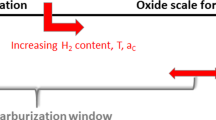Conclusions
-
1.
An increase in hydrogen partial pressure in an N2−H2−CH4 gaseous mixture promotes an increase in the flow of carbon into the steel as a result of the increase in the diffusion mobility of methane in the Nernst layer.
-
2.
The effective diffusion coefficient of carbon in unalloyed austenite in carburzing of steels in nitrogen-hydrogen mixtures with pure methane significantly exceeds the actual diffusion coefficient of it and increases with an increase in the partial pressures of hydrogen and methane.
-
3.
In carburizing in an N2−H2−CH4 mixture there is observed the mutual influence of carbon and hydrogen on the kinetics of establishment of equilibrium with the steel with respect to hydrogen, which is probably caused by the existence of C−H complexes.
-
4.
Carburizing in nitrogen-hydrogen mixtures with additions of pure methane may be intensified by increasing the partial pressures of methane and hydrogen and also by increasing the frequency of change as the result of the use of higher capacity centrifugal blowers.
Similar content being viewed by others
Literature cited
B. M. Éstrin, O. S. Mnushkin, M. A. Shkol'nikov, and V. A. Rudman, "Carburizing of steel in nitrogen-hydrogen mixtures with additions of pure methane," Metalloved. Term. Obrab. Met., No. 5, 26–29 (1984).
A. N. Minkevich, Chemicothermal Treatment of Metals and Alloys [in Russian], Mashinostroenie, Moscow (1965).
R. Coolin, S. Gunnarson, and D. Thulin, "Ein Mathematschen Modell zur Berechnung von Aufkohlungsprofilen bei der Gasaufkohlung," Härterei Tech. Mitt.,25, No. 1, 17–22 (1970).
R. Hoffman and F. Neumann, "Gedanken zum Kohlenstoffübergang beim Aufkohlen von Stahl," Härterei Tech. Mitt.,27, No. 3, 157–162 (1972).
N. B. Vargaftik, Handbook on the Thermophysical Properties of Gases and Liquids [in Russian], Nauka, Moscow (1972).
P. A. Tesner, The Formation of Carbon from Hydrocarbons of the Gaseous Phase [in Russian], Khimiya, Moscow (1972).
A. V. Lykov, The Theory of Thermal Conductivity [in Russian], Vysshaya Shkola, Moscow (1967).
M. A. Krishtal, The Diffusion Mechanism in Iron Alloys [in Russian], Metallurgiya, Moscow (1972).
O. S. Mnushkin and B. M. Éstrin, "The interaction of steel with hydrogen in heat treatment in controlled atmospheres," Metalloved. Term. Obrab. Met., No. 11, 50–52 (1983).
Additional information
Central Council on Power in Ferrous Metallurgy. Translated from Metallovedenie i Termicheskaya Obrabotka Metallov, No. 8, pp. 7–11, August, 1986.
Rights and permissions
About this article
Cite this article
Éstrin, B.M., Mnushkin, O.S. & Shkol'nikov, M.A. Influence of hydrogen on the carburizing of steel in nitrogen-hydrogen mixtures with the addition of pure methane. Met Sci Heat Treat 28, 542–547 (1986). https://doi.org/10.1007/BF00795273
Issue Date:
DOI: https://doi.org/10.1007/BF00795273




